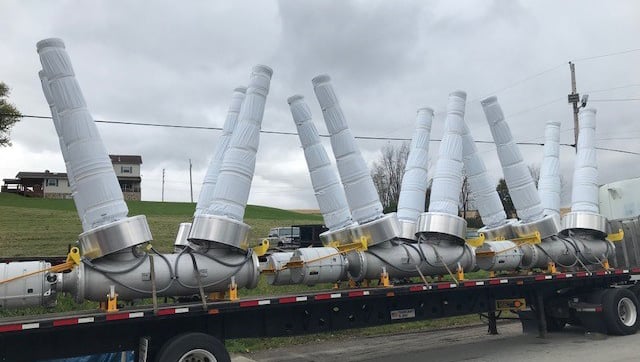Common Challenges of Flatbed Shipping
Flatbed shipping can be an expensive mode of transportation – especially when your products are damaged from being exposed to the elements – so it’s important to ensure your assets have the proper protection.
Shrink wrap and tarps (two of the most common covering methods) leave your products and equipment vulnerable to the various dangers and challenges of flatbed shipping.
When you take a closer look at these challenges, it’s easy to see how flatbed shipping can risk the quality of your products and leave you vulnerable to unnecessary costs down the road.
Road Hazard Prevention
When a piece of equipment is traveling via flatbed, it’s obviously exposed to the elements and all kinds of weather conditions which are becoming more unpredictable. From high-speed winds to destructive hail to blazing hot sun exposure, the elements can wreak havoc on the condition of your equipment. Plus, the speed of flatbed shipping exposes your products to everyday hazards of the road. Things like road chips, moisture, debris impact, wind tunneling, etc., can all cause extensive damage to a piece of equipment that isn’t properly protected.
Even if the unit you’re shipping is meant to be outside, end customers expect an unblemished product to arrive. If the equipment shows up damaged, or even slightly bruised, it can potentially cost a lot of money in warranty claims, in-person damage inspection, and so on. And in today’s environment of part/material shortages, it’s crucial to mitigate as much damage risk as possible to save yourself money, time, and hassle later.
Securing and Strapping on the Flatbed
Securing a product on a flatbed typically involves the use of four-inch truck strapping in order to eliminate movement and hold the item in place. This kind of strapping requires an extreme amount of tension, which puts serious, constant stress on whatever product is being held down. This is another point where the covering material being used between your product and the strapping becomes invaluable.
Without the proper protection and reinforcement in areas where the strapping is making contact with the item, the pressure of the straps can damage surfaces, and bend, dent, or even crush the product they’re securing.
Additionally, the constant vibration and movement of flatbeds can begin to loosen the strapping, which can result in the shifting of their position. Even the slightest decrease in strap tension can cause etching and scratching on the surface of your product.
Proper Weight Distribution
Flatbed shipping relies heavily on the proper distribution of weight to keep both the truck and equipment being shipped in balance. If the weight on the trailer isn’t balanced properly, the truck is likely to sway back and forth during transit. Beyond risking your product shifting – or worse, falling – this can be a hazard to both the driver and fellow travelers.
It’s vital to ensure quality protection and safe weight distribution.
On/Off Lifting Preparation
Depending on the equipment being shipped, dunnage (wood or lumber, usually) should be attached for easier lifting and to act as a barrier between the equipment and the platform of the flatbed. If dunnage isn’t prepared and applied before the item is placed on the flatbed, it can cause delays in shipment. And if not applied at all, it will mean less security during transit.
Whether with or without dunnage, having the proper cover protection installed on your equipment is an integral part of keeping the quality of your product ensured.
Your Equipment Transportation Solution
When shipping your equipment and products via flatbed, there are steps you should be taking to fight against the predictable and unpredictable challenges of transit. While you can’t control the weather or road hazards and conditions, you can make sure your products are ready to face whatever the shipment journey has in store, including the necessary security precautions taken when using flatbed shipping.
Transhield cover solutions allow you to minimize risks and provide the best protection the industry has to offer. From the elements to road hazards to the handling and security of your product, our covers are custom designed for your unique items and can withstand everything from simple surface damage to intense structural risks.
If you are using shrink wrap to cover your equipment during transportation, contact Transhield today. We can help you save time, money and aggravation during the unpredictable shipping process.
Learn more about our superior cover technology.
